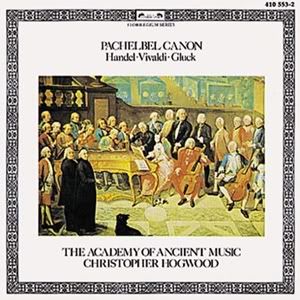I have both the much loved and played LP, and when cd's came out, Hubby brought a copy from Europe.
From the Academy of Ancient Music website:There are no videos of the Academy of Ancient Music on Youtube, but this one at least comes close, if not exactly in sound but in their intention.
Handel: Overture, Minuet & Gigue from ‘Berenice’;
Handel: Air & Hornpipe from ‘The Water Music’
Vivaldi: Concerto for 4 violins & cello;
Vivaldi: Concerto for 2 trumpets
Gluck: Dance of the Furies;
Gluck: Dance of the Blessed SpiritsThe Academy of Ancient Music
Christopher Hogwood
Decca L’Oiseau-Lyre 410 553-2OH
Performed on original instruments by Voices of Music. Featuring Katherine Kyme, Carla Moore & Cynthia Freivogel, baroque violin; Tanya Tomkins, baroque cello, Hanneke van Proosdij, baroque organ; David Tayler, theorbo.
About the performance: the canon is played using not only the instruments but also the bowing techniques from the time of Pachelbel. As you can see from the video, especially if you look at the high definition version, the string instruments are not only baroque, but they are in baroque setup: this means that the strings, fingerboard, bridge and other parts of the violin appear just as they did in Pachelbel's time. No metal hardware such as chinrests, clamps or fine tuners are used on the violins, allowing the violins to vibrate freely. A good example of baroque bowing can be seen in the extended passage of repeated notes: the musicians play these notes on one bow—the shorter & lighter baroque bow—to created a gliding effect. The players also hold the bow very differently which affects the balance and touch. Both the style and the amount of vibrato are based on baroque treatises which describe the methods for playing, bowing & articulation in the late 17th century. The narrow, shimmering vibrato blends with the baroque organ. The organ used is made entirely of wood, based on German baroque instruments, and the pipes are voiced to provide a smooth accompaniment to the strings, instead of a more soloistic sound. The large bass lute, or theorbo, provides a complement to the organ not only in the texture of the chords but also the long strings which occasionally sound the bass notes an octave lower. The continuo players play supporting chords and voices to the canon, carefully avoiding parallels and doublings of the parts.
Another feature of the video is the subtle differences in not only the sound and color of the instruments, but also the different techniques of the players. All three are playing baroque violins with baroque bows, yet each person has her own distinct sound and bowing style—each bow has a different shape and balance. If you look at paintings of 17th century players you will see that they are all different, because that individuality of sound and technique was highly valued. This allows the players and the listeners to hear and appreciate the "Voices of Music."







No comments:
Post a Comment